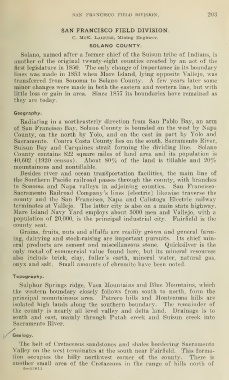Page 232 - miningincalif1927
P. 232
SAN FRANCISCO FIELD DIVISION. 203
SAN FRANCISCO FIELD DIVISION.
C. McK. Laizure, Mining Engineer.
SOLANO COUNTY.
Solano, named after a former chief of the Suisun tribe of Indians, is
another of the original twenty-eight counties created by an act of the
first legislature in 1850. The only change of importance in its boundary
lines was made in 1853 when Mare Island, lying opposite Vallejo, was
transferred from Sonoma to Solano County. A few years later some
minor changes were made in both the eastern and western line, but with
little loss or gain in area. Since 1857 its boundaries have remained as
they are today.
Geography.
Radiating in a northeasterly direction from San Pablo Bay, an arm
of San Francisco Bay, Solano County is bounded on the west by Napa
County, on the north by Yolo, and on the east in part by Yolo and
Sacramento. Contra Costa County lies on the south, Sacramento River,
Suisun Bay and Carquinez strait forming the dividing line. Solano
County contains 822 square miles of land area and its population is
40,602 (1920 census). About 80% of the land is tillable and 20%
mountainous and nontillable.
Besides river and ocean transportation facilities, the main line of
the Southern Pacific railroad passes through the county, with branches
to Sonoma and Napa valleys in adjoining counties. San Francisco-
Sacramento Railroad Company's lines (electric) likewise traverse the
county and the San Francisco, Napa and Calistoga Electric railway
terminates at Vallejo. The latter city is also on a main state highway.
Mare Island Navy Yard employs about 5000 men and Vallejo, with a
population of 20,000, is the principal industrial city. Fairfield is the
county seat.
Grains, fruits, nuts and alfalfa are readily grown and general farm-
ing, dairying and stock-raising are important pursuits. Its chief min-
eral products are cement and miscellaneous stone. Quicksilver is the
only metal of commercial value found here, but its mineral resources
also include brick, clay, fuller's earth, mineral w ater, natural gas,
T
onyx and salt. Small amounts of chromite have been noted.
Topography.
Sulphur Springs ridge, Vaca Mountains and Blue Mountains, which
the western boundary closely follows from south to north, form the
principal mountainous area. Potrero hills and Montezuma hills are
isolated high lands along the southern boundary. The remainder of
the county is nearly all level valley and delta land. Drainage is to
south and east, mainly through Putah creek and Suisun creek into
Sacramento River.
Geology.
The belt of Cretaceous sandstones and shales bordering Sacramento
Valley on the west terminates at the south near Fairfield. This forma-
tion occupies the hilly northwest corner of the county. There is
another small area of the Cretaceous in the range of hills north of
6—52012

